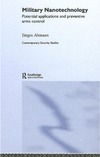This book is the first systematic and comprehensive presentation of the potential military applications of nanotechnology (NT). After a thorough introduction and overview of nanotechnology and its history, it presents the actual military NT R&D in the USA and gives a systematic description of the potential military applications of NT that may include in 10-20 years extremely small computers, miniature sensors, lighter and stronger materials in vehicles and weapons, autonomous systems of many sizes and implants in soldiers' bodies. These potential applications are assessed from a viewpoint of international security, considering the new criteria of dangers for arms control and the international law of warfare, dangers for stability through potential new arms races and proliferation, and dangers for humans and society.
Although some applications (e.g. sensors for biological-warfare agents) could contribute to better protection against terrorist attacks or to better verification of compliance with arms-control treaties, several potential uses, like metal-free firearms, small missiles or implants and other body manipulation raise strong concerns. For preventive limitation of these potentially dangerous applications of NT, specific approaches are proposed that balance positive civilian uses and take into account verification of compliance.
This book will be of much interest to students of strategic studies, peace studies, conflict resolution and international security, as well as specialists in the fields of military technology and chemical-biological weapons.
 |
|
О проекте
|
|
О проекте


